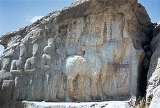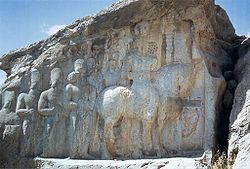
Naqsh-e Rajab
Encyclopedia

Istakhr
Estakhr was an ancient city located in southern Iran, in Fars province, five kilometers north of Persepolis. It was a prosperous city during the time of Achaemenid Persia.-History:...
and about 12 km north of Persepolis
Persepolis
Perspolis was the ceremonial capital of the Achaemenid Empire . Persepolis is situated northeast of the modern city of Shiraz in the Fars Province of modern Iran. In contemporary Persian, the site is known as Takht-e Jamshid...
.
Together with Naqsh-e Rustam
Naqsh-e Rustam
Naqsh-e Rustam also referred to as Necropolis is an archaeological site located about 12 km northwest of Persepolis, in Fars province, Iran. Naqsh-e Rustam lies a few hundred meters from Naqsh-e Rajab....
, which lies less than a kilometer away, the site is part of the Marvdasht cultural complex. Together, the two sites are a tentative candidate for UNESCO World Heritage
World Heritage Site
A UNESCO World Heritage Site is a place that is listed by the UNESCO as of special cultural or physical significance...
status.
Naqsh-e Rajab is the site of four limestone rockface inscriptions and bas-reliefs that date to the early Sassanid era
Sassanid Empire
The Sassanid Empire , known to its inhabitants as Ērānshahr and Ērān in Middle Persian and resulting in the New Persian terms Iranshahr and Iran , was the last pre-Islamic Persian Empire, ruled by the Sasanian Dynasty from 224 to 651...
. One of the carvings is the investiture inscription of Ardeshir I (r. 226 - 241), the founder of the dynasty. The second investiture inscription is Ardeshir's successor, Shapur I
Shapur I
Shapur I or also known as Shapur I the Great was the second Sassanid King of the Second Persian Empire. The dates of his reign are commonly given as 240/42 - 270/72, but it is likely that he also reigned as co-regent prior to his father's death in 242 .-Early years:Shapur was the son of Ardashir I...
(r. 241 - 272). A third bas-relief, known as 'Shapur's Parade' celebrates the king's military victory in 244 over the Roman emperor Valerian I and Philip the Arab
Philip the Arab
Philip the Arab , also known as Philip or Philippus Arabs, was Roman Emperor from 244 to 249. He came from Syria, and rose to become a major figure in the Roman Empire. He achieved power after the death of Gordian III, quickly negotiating peace with the Sassanid Empire...
. A fourth bas-relief and inscription is attributed to Kartir
Kartir
Kartir Hangirpe was a highly influential Zoroastrian high-priest of the late 3rd century CE and served as advisor to at least three Sassanid emperors....
, high priest under Shapur I and his sons Hormizd I
Hormizd I
Hormizd I was the third Sassanid King of Persia from 270/72 to 273.He was the youngest son of Shapur I , under whom he was governor of Khorasan, and appears in his wars against Rome Hormizd I was the third Sassanid King of Persia from 270/72 to 273.He was the youngest son of Shapur I...
(r. 272 - 273) and Bahram I
Bahram I
Bahram I was the fourth Sassanid emperor of the second Persian Empire. He was the eldest son of Shapur I and succeeded his brother Hormizd I , who had reigned for only a year....
(r. 273 – 276).
See also
- List Of Colossal Sculpture In Situ
- Naqsh-e RustamNaqsh-e RustamNaqsh-e Rustam also referred to as Necropolis is an archaeological site located about 12 km northwest of Persepolis, in Fars province, Iran. Naqsh-e Rustam lies a few hundred meters from Naqsh-e Rajab....
- Taq-e BostanTaq-e BostanTaqwasân or Taq-e Bostan or Taq-i-Bustan is a series of large rock relief from the era of Sassanid Empire of Persia, the Iranian dynasty which ruled western Asia from 226 to 650 AD. This example of Sassanid art is located 5 km from the city center of Kermanshah in western Iran...
, another site of Sassanid-era rock reliefs.

